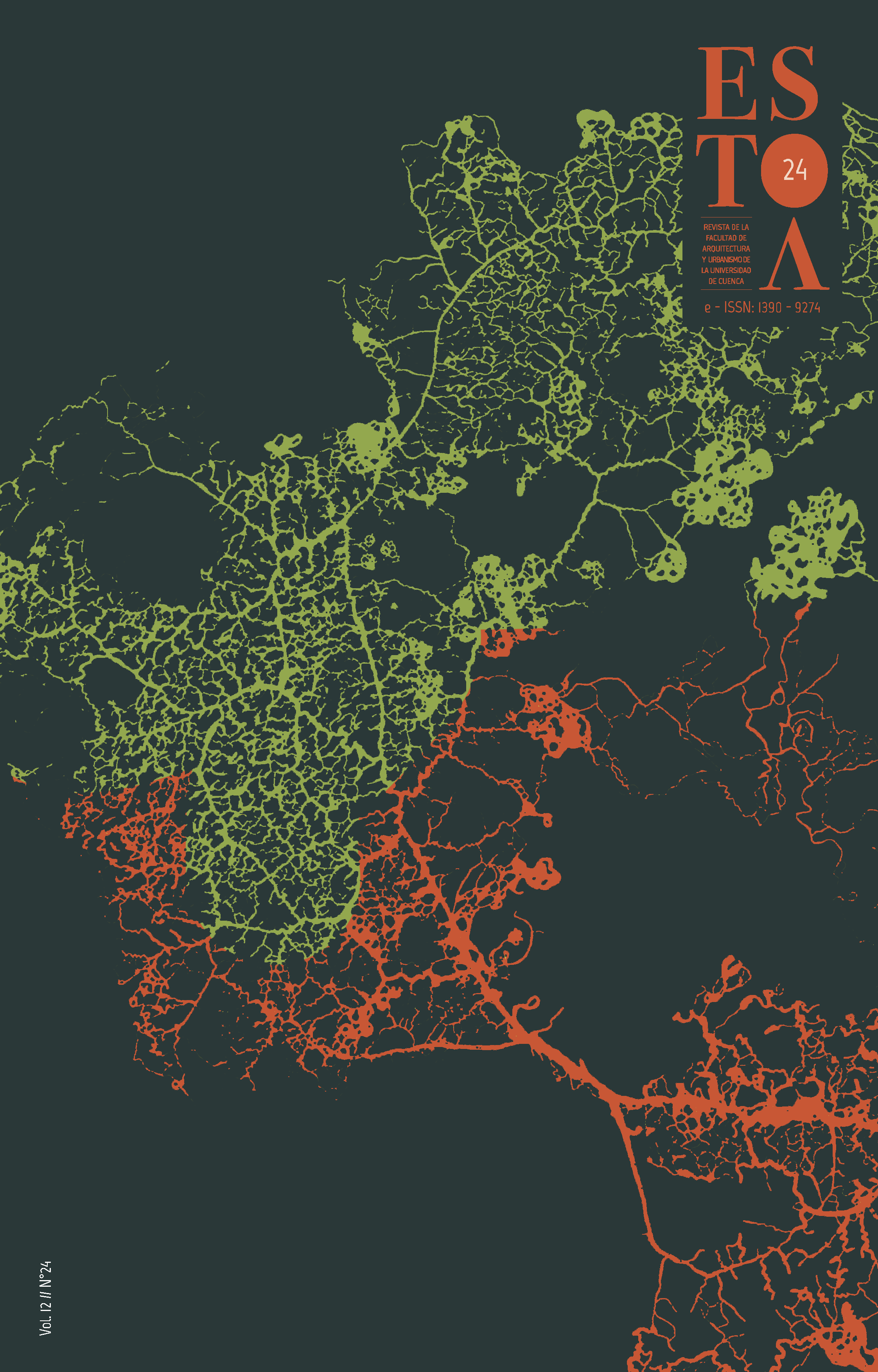German first post-war modern urban planning principles
DOI:
https://doi.org/10.18537/est.v012.n024.a03Keywords:
small dwelling, urban form, German modern-city, planning principles, modern SiedlungAbstract
The change in the German urban paradigm in the first post-war period in Europe places the inhabitant at the center of the city’s configuration. The war supposes the determining factor that concludes the period of representation of the compact town and initiates a new urban approach in which the man, the house, and nature configure the new physical reality. This modern city condenses the efforts that for decades have tried to transform the stony body of the industrial city, giving rise to new urbanization criteria that, regardless of any stylistic affiliation, are common to the entire German territory. From the study of primary sources of the period, this article compiles these principles of the modern German urban planning in the form of a decalogue.
Downloads
References
Adickes, F. y Hinckeldeyn, K. (1895). Die Notwendigkeit weiträumiger Bebauung bei Stadterweiterungen. En Deutschen Vierteljahrsschrift fur offentliche Gesundheitspfleg, XXVII(H.1). Vieweg & Sohn.
Arredondo Garrido, D. (2018). La influencia de Leberecht Migge en la creación de las Siedlungen productivas modernas. VLC arquitectura. Research Journal, 5(2), 29-58. https://doi.org/10.4995/vlc.2018.8641
Bosch Abarca, J. (2017). Theodor Goecke. La vivienda pequeña en el debate urbano alemán de final del S.XIX. VLC arquitectura. Research Journal, 4(2), 87-118. https://doi.org/10.4995/vlc.2017.6967
Bullock, N. y Read, J. (2010). The movement for housing reform in Germany and France, 1840-1914. En Cambridge urban and architectural studies (Vol. 9). Cambridge University Press. http://www.gbv.de/dms/bowker/toc/9780521133838.pdf
Collins, G. R., Collins, C. C. y Sitte, C. (1980). Camillo Sitte y el nacimiento del urbanismo moderno: Construccion de ciudades según principios artísticos. En Biblioteca de arquitectura. Gustavo Gili.
Ehlgötz, V. (1928). Die Aufschliessung des Baugeländes. En Der Wohnungsbau in Deutschland nach dem Weltkriege seine Entwicklung unter der unmittelbaren und mittelbaren Förderung durch die deutschen Gemeindeverwaltungen. Bruckmann.
Fuchs, C. J. (1928). Die Beschafung von Baugelände. En A. Gut (Ed.), Der Wohnungsbau in Deutschland nach dem Weltkriege seine Entwicklung unter der unmittelbaren und mittelbaren Förderung durch die deutschen Gemeindeverwaltungen (pp. 51-64). Bruckmann.
Goecke, T. (1893). Verkehrsstrasse und Wohnstrasse. Preussische Jahrbucher, 73(1), 85-104.
Goecke, T. (1916). Neue Bücher und Schriften. Der Städtebau, 13(2/3), 30. http://pbc.gda.pl/dlibra/docmetadata?id=11597&from=publication
Gut, A. (1928). Der Wohnungsbau in Deutschland nach dem Weltkriege seine Entwicklung unter der unmittelbaren und mittelbaren Förderung durch die deutschen Gemeindeverwaltungen. Bruckmann.
Hoffmann, C. W. (1852). Die Wohnungen der Arbeiter und Armen. En Hft. 1. Die Berliner Gemeinnützige Bau-Gesellschaft: Vol. H.1. Schroeder.
Kähler, G. (1985). Wohnung und Stadt. Vieweg & Sohn.
Maxwell, J. A. y Reybold, L. E. (2015). Qualitative Research. En International Encyclopedia of the Social & Behavioral Sciences (pp. 685-689). Elsevier. https://doi.org/10.1016/B978-0-08-097086-8.10558-6
Möhring, B., Eberstadt, R. y Petersen, R. (1911). Preisgekrönt mit dem III. Preise. Kennwort: «Et in Terra Pax». En Wasmuth (Ed.), Wettbewerb Gross-Berlin, 1910; Die preisgekronten Entwurfe mit Erläuterungsberichten. (pp. 1-32). Wasmuth.
Mulert, O. (1928). Zum Geleit. En A. Gut (Ed.), Der Wohnungsbau in Deutschland nach dem Weltkriege seine Entwicklung unter der unmittelbaren und mittelbaren Förderung durch die deutschen Gemeindeverwaltungen (pp. 9-12). Bruckmann.
Muthesius, H. (1910). Städtebau. Kunst und Künstler, VIII, 531-535. http://digi.ub.uni-heidelberg.de/diglitkk1910/ 0543?sid=e974033efed2e9f8a02048e9b7582677
Posener, J. (1979). Berlin auf dem Wege zu einer neuen Architektur. Das Zeitalter Wilhelms II. Prestel.
Sitte, C. y Canosa, E. (1926). Construcción de ciudades según principios artísticos. E. Canosa (ed).
Sonne, W. (2010). Stadtbaukunst als Konzept: ein internationales Phänomen un 1900. IMS. Der Wettweberb Gross-Berlin 1910 im internationales Kontext., 1, 14-27.
Tubbesing, M. (2010). Ein preussischer Pionier im transatlantischen Diskurs. Ministerial-Oberbaudirektor und Wirklicher Geheimrat Excellenz Karl Hynckeldeyn. IMS. Der Wettweberb Gross-Berlin 1910 im internationales Kontext., 1, 54-67.
Vereinigung berliner Architekten. (1907). Vereinigung Berliner Architekten und dem Architektenverein zu Berlin: Anregungen zur Erlangung eines Grundplanes für die städtebauliche Entwicklung von Gross-Berlin. Wasmuth.
Wagner, M. (1915). Sanitäre Grün der Städte. Ein Beitrag zur Freiflächentheorie. Carl Heymanns Verlag.
Published
How to Cite
Issue
Section
License
Copyright (c) 2023 Estoa. Revista de la Facultad de Arquitectura y Urbanismo

This work is licensed under a Creative Commons Attribution-NonCommercial-ShareAlike 4.0 International License.
The Journal declines any responsibility for possible conflicts derived from the authorship of the works that are published in it.
The University of Cuenca in Ecuador conserves the patrimonial rights (copyright) of the published works and will favor the reuse of the same ones, these can be: copy, use, diffuse, transmit and expose publicly.
Unless otherwise indicated, all contents of the electronic edition are distributed under a Creative Commons Attribution-NonCommercial-ShareAlike 4.0 International License.




